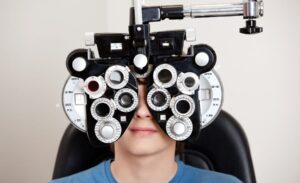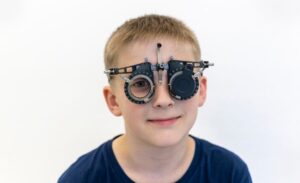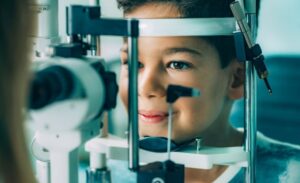Understanding Myopia Control
To embark on the path of myopia control, it is essential to first understand what myopia is, recognize the importance of controlling its progression, and become acquainted with the concept of myopia control exercises.
What is Myopia?
Myopia, commonly known as nearsightedness, is a refractive error that affects the ability to see distant objects clearly. Individuals with myopia experience clear vision up close but struggle to focus on objects in the distance. This occurs when the eyeball is slightly elongated, causing light rays to focus in front of the retina instead of directly on it.
Myopia is a prevalent condition, especially among children and young adults. Its prevalence has been steadily increasing globally, making it a significant public health concern. Understanding the nature of myopia is crucial in order to explore effective strategies for managing and controlling its progression.
Importance of Myopia Control
Recognizing the importance of myopia control is key in addressing this condition effectively. Uncontrolled myopia can lead to various complications and impact visual health in the long term. High levels of myopia are associated with an increased risk of eye conditions such as cataracts, glaucoma, and retinal detachment.
Moreover, myopia can affect a child’s academic performance and overall well-being. The need for corrective lenses, such as glasses or contact lenses, can cause inconvenience and affect self-esteem. By implementing effective myopia control measures, it is possible to slow down the progression of myopia and reduce the risks associated with high myopia.
Introducing Myopia Control Exercises
One approach to myopia control that has gained attention is the use of myopia control exercises. These exercises aim to strengthen the eye muscles, improve focusing ability, and reduce eye strain associated with near work activities. While myopia control exercises cannot reverse myopia, they may help slow down its progression, particularly in children.
Myopia control exercises typically involve a combination of techniques focused on reducing the strain caused by extended periods of near work, such as reading or using digital devices. These exercises often include near work breaks, which involve taking short breaks every 20 minutes to look at distant objects, and increasing outdoor time, as exposure to natural light has been associated with a reduced risk of myopia progression.
Additionally, accommodation exercises may be recommended. Accommodation refers to the ability of the eyes to change focus from near to distant objects. Exercises that challenge and train the accommodation system can help improve the overall visual function and potentially contribute to myopia control.
To implement myopia control exercises effectively, it is important to establish a routine, seek professional guidance, and track progress over time. These exercises are just one aspect of the broader range of myopia control methods available. To explore other approaches, such as the use of contact lenses or pharmaceutical interventions, refer to our articles on myopia control contact lenses, myopia control lenses, and myopia control drops.
By understanding myopia and the significance of controlling its progression, as well as exploring myopia control exercises, parents can take proactive steps to safeguard their children’s visual health and enhance their quality of life.
Benefits of Myopia Control Exercises
Myopia control exercises offer several benefits for individuals looking to manage and slow down the progression of myopia. These exercises are designed to target specific aspects of visual function and can provide significant advantages in the long run. Let’s explore some of the key benefits of incorporating myopia control exercises into a routine.
Slowing Down Myopia Progression
One of the primary goals of myopia control exercises is to slow down the progression of myopia. By engaging in these exercises regularly, individuals can potentially reduce the rate at which their myopia worsens over time. Slowing down myopia progression is particularly important for children, as it can help prevent the need for stronger eyeglass prescriptions and potential associated eye health risks in the future. Research has shown that certain myopia control exercises, such as near work breaks and outdoor time, can be effective in this regard. For more information on myopia control methods, visit our article on myopia control.
Improving Visual Comfort
Myopia control exercises can also improve visual comfort, especially for individuals who spend a significant amount of time engaged in near work activities such as reading or using digital devices. These exercises often involve techniques to relax and alleviate strain on the eyes. By incorporating regular breaks, practicing relaxation exercises, or implementing techniques to reduce eye fatigue, individuals can experience increased comfort during prolonged near work activities.
Enhancing Visual Function
Engaging in myopia control exercises can enhance visual function, including aspects such as focusing ability, eye coordination, and depth perception. These exercises target specific visual skills and help to improve their efficiency. By enhancing visual function, individuals may experience improved visual clarity and overall visual performance, which can positively impact their daily activities and tasks that require clear vision.
It’s important to note that while myopia control exercises can provide benefits, they are most effective when implemented alongside other myopia control methods, such as myopia control contact lenses, myopia control lenses, or myopia control drops. These methods can work synergistically to provide comprehensive myopia control.
By incorporating myopia control exercises into a daily routine, individuals can potentially experience the benefits of slowed myopia progression, improved visual comfort, and enhanced visual function. It’s important to establish a consistent routine, seek professional guidance, and track progress over time to effectively monitor the impact of these exercises. Remember to consult with an eye care professional to determine the most suitable exercises for your specific needs.
Types of Myopia Control Exercises
When it comes to myopia control, incorporating specific exercises into daily routines can play a significant role in managing the progression of myopia. These exercises can help alleviate strain on the eyes and potentially slow down the progression of myopia. Let’s explore three common types of myopia control exercises: near-work breaks, outdoor time, and accommodation exercises.
Near Work Breaks
One key factor contributing to myopia is excessive near work, such as reading or using digital devices for extended periods. Near work can strain the eyes and lead to myopia progression. Taking regular near-work breaks can help alleviate this strain. Here’s a simple routine to follow:
- Set a timer or use an app to remind yourself or your child to take breaks every 20 minutes.
- During each break, encourage looking at a distant object or scene for at least 20 seconds.
- This practice allows the eyes to relax and refocus away from near work, reducing the strain on the eyes.
By incorporating near-work breaks into daily routines, individuals can provide their eyes with much-needed rest and potentially slow down the progression of myopia.
Outdoor Time
Spending time outdoors has been shown to have a positive impact on myopia control. The benefits of outdoor time may be attributed to factors such as increased exposure to natural light and the ability to focus on objects in the distance. Here are a few tips to maximize the benefits of outdoor time:
- Encourage regular outdoor activities, such as playing sports, walking, or simply spending time in nature.
- Aim for at least two hours of outdoor time each day, preferably under well-lit conditions.
- Encourage activities that involve focusing on distant objects, such as playing catch or exploring the surroundings.
By incorporating outdoor time into daily routines, individuals can potentially slow down the progression of myopia and promote overall eye health.
Accommodation Exercises
Accommodation exercises focus on improving the flexibility and focusing ability of the eyes. These exercises help the eyes adjust between near and distant objects more efficiently. Here are a few examples of accommodation exercises:
- Near-Far Focus: Hold a small object, such as a pencil, close to your face. Gradually shift your focus to a distant object and then back to the pencil. Repeat this exercise several times.
- Near-Far Reading: Hold a book or text at a comfortable reading distance. After a few minutes, shift your focus to a distant object and then back to the text. Repeat this exercise periodically during reading sessions.
- Eye Rolling: Roll your eyes clockwise and then counterclockwise. This exercise helps improve eye-muscle coordination and flexibility.
It’s important to note that while these exercises may potentially slow down myopia progression, they should be practiced under the guidance of a qualified eye care professional.
By incorporating these myopia control exercises into daily routines, individuals can proactively manage the progression of myopia. Remember, it’s crucial to consult with an optometrist or ophthalmologist for personalized guidance on which exercises are most suitable for you or your child’s specific needs. For more information on different myopia control methods, visit our article on myopia control methods.
Implementing Myopia Control Exercises
To effectively incorporate myopia control exercises into your daily routine, it is important to establish a consistent routine, seek professional guidance, and track your progress along the way.
Establishing a Routine
Establishing a regular routine for myopia control exercises is crucial for achieving the desired results. Consistency is key when it comes to implementing these exercises. Set aside specific times during the day for your child to engage in these activities. This will help ensure that the exercises become a habit and are integrated seamlessly into their daily lives.
Consider creating a schedule that includes dedicated time for near-work breaks, outdoor activities, and accommodation exercises. By incorporating these exercises into their daily routine, your child will have a higher chance of benefiting from myopia control. Remember, it’s important to strike a balance between engaging in these exercises and maintaining other aspects of their daily routine.
Seeking Professional Guidance
While myopia control exercises can be simple and effective, it is always advisable to seek professional guidance. Consult with an eye care professional who specializes in myopia control to better understand your child’s specific needs and the most suitable exercises for them. A professional can provide personalized recommendations based on your child’s age, visual health, and lifestyle.
An eye care professional can also assess your child’s progress over time and make necessary adjustments to the exercise routine. Regular check-ups with an optometrist or ophthalmologist who specializes in myopia control will ensure that your child’s eyes are monitored and that their myopia progression is effectively managed.
Tracking Progress
Tracking the progress of your child’s myopia control journey is an essential part of the process. By monitoring their progress, you can determine the effectiveness of the exercises and make any necessary adjustments. Keep a record of their visual acuity measurements, changes in prescription, and any other relevant observations.
Regular visits to the eye care professional will provide an opportunity to review your child’s progress and make informed decisions about the continuation or modification of the exercise routine. By tracking their progress, you can ensure that the chosen myopia control exercises are benefiting your child and contributing to the desired outcomes.
Remember, myopia control exercises are just one aspect of managing myopia. It is important to consider other factors, such as lifestyle habits and environmental factors, which may contribute to myopia progression. For a comprehensive approach to myopia control, it may be necessary to combine exercises with other myopia control methods. Consult with an eye care professional to explore additional options that may be suitable for your child’s specific needs.
Implementing myopia control exercises requires commitment and regular monitoring. By establishing a routine, seeking professional guidance, and tracking progress, you can effectively incorporate these exercises into your child’s daily life and take a proactive approach to managing myopia.
Additional Considerations
In addition to incorporating myopia control exercises into your routine, there are several other factors to consider when addressing myopia control. These include lifestyle factors, eye health and safety, and the potential benefits of combination approaches.
Lifestyle Factors
Certain lifestyle factors can impact the progression of myopia. Spending excessive time engaging in near work activities, such as reading or using electronic devices, has been associated with an increased risk of myopia development and progression. Encouraging children to take frequent near work breaks and engage in outdoor activities can help reduce the strain on their eyes and potentially slow down the progression of myopia. Our article on outdoor time provides more information on the benefits of spending time outdoors for myopia control.
Eye Health and Safety
When implementing myopia control exercises or any other myopia control methods, it’s crucial to prioritize eye health and safety. Regular eye examinations by a qualified eye care professional are essential to monitor the progression of myopia and ensure the overall health of the eyes. A professional can provide guidance on suitable exercises and monitor the effectiveness of the chosen approach. It’s important to follow their recommendations and seek their expertise throughout the myopia control journey. Learn more about different myopia control methods in our article on myopia control methods.
Combination Approaches
While myopia control exercises can be beneficial, it’s important to note that combination approaches may yield better results. Combining different methods, such as myopia control exercises, specialized myopia control contact lenses, or myopia control drops, can provide a comprehensive approach to managing myopia progression. These combinations can be tailored to individual needs and may be more effective than relying on a single method alone. It’s important to consult with an eye care professional to determine the most suitable combination approach for your child. Our article on myopia control research discusses the latest advancements in myopia control and the potential benefits of combining different strategies.
By considering these additional factors, you can optimize your approach to myopia control and potentially improve the outcome for your child. Remember to consult with a qualified eye care professional who can guide you based on your child’s specific needs and monitor their progress. Together, with a comprehensive approach, you can take significant steps towards managing and controlling myopia.
Conclusion
In conclusion, myopia control exercises offer a promising approach to managing myopia progression in children. By incorporating these exercises into their daily routines, parents can potentially slow down the progression of myopia, improve visual comfort, and enhance visual function.
It is important to understand that myopia control exercises are just one component of a comprehensive myopia control strategy. Other options such as myopia control contact lenses, myopia control lenses, and myopia control drops exist and may be recommended based on the specific needs of the child. Consulting with an eye care professional who specializes in myopia control is essential to determine the most suitable approach for your child. For more information about myopia control methods and options, refer to our article on myopia control.
When implementing myopia control exercises, establishing a consistent routine is crucial. Encouraging regular near work breaks, ensuring sufficient outdoor time, and incorporating accommodation exercises can make a significant difference in managing myopia progression. Tracking your child’s progress through regular eye examinations and maintaining open communication with the eye care professional are also important steps to ensure the effectiveness of the chosen myopia control strategy.
It is worth noting that lifestyle factors, such as the amount of time spent indoors and engagement in outdoor activities, can also influence myopia progression. Encouraging a healthy balance of activities and taking steps to promote good eye health, such as ensuring proper lighting and maintaining a safe working distance from electronic devices, can further support the effectiveness of myopia control exercises. For more information about myopia control in adults, you may find our article on myopia control in adults helpful.
In some cases, a combination of different myopia control approaches may be recommended to achieve optimal results. This could include a combination of exercises, contact lenses, or other interventions, tailored to the individual needs of the child. Ongoing myopia control research continues to explore new possibilities and refine existing strategies, so it is important to stay informed about the latest advancements in the field. For more information on the latest research, you may refer to our article on myopia control research.
By implementing myopia control exercises and considering the various factors discussed, parents can take an active role in managing their child’s myopia and supporting their long-term eye health. Together with the guidance of an eye care professional, parents can pave the way to clearer sight and a brighter future for their children.











